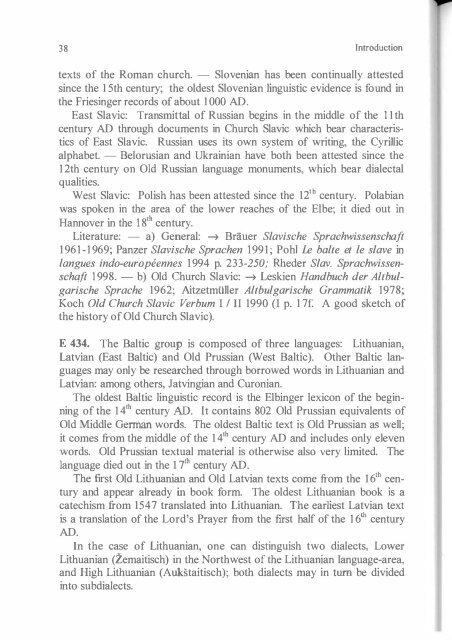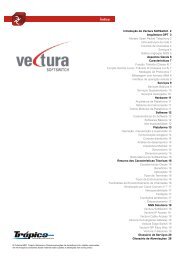You also want an ePaper? Increase the reach of your titles
YUMPU automatically turns print PDFs into web optimized ePapers that Google loves.
38 Introductiontexts <strong>of</strong> the Roman church. - Slovenian has been continually attestedsince the 15th century; the oldest Slovenian linguistic evidence is fo und inthe Friesinger records <strong>of</strong> about 1000 AD.East Slavic: Transmittal <strong>of</strong> Russian begins in the middle <strong>of</strong> the I1 thcentury AD through documents in Church Slavic which bear characteristics<strong>of</strong> East Slavic. Russian uses its own system <strong>of</strong> writing, the Cyrillicalphabet. - Belorusian and Ukrainian have both been attested since the12th century on Old Russian language monuments, which bear dialectalqualities.West Slavic: Polish has been attested since the Ith century. Polabianwas spoken in the area <strong>of</strong> the lower reaches <strong>of</strong> the Elbe; it died out inHannover in the 18th century.Literature: - a) General: Brauer Slavische Sprachwissenschaft1961-1969; Panzer Slavische Sprachen 1991; Pohl Le balte et le slave inlangues indo-europeennes 1994 p. 233-250; Rheder Slav. Sprachwissenschaft1998. - b) Old Church Slavic: Leskien Handbuch der AltbulgarischeSprache 1962; Aitzetmiiller Altbulgarische Grammatik 1978;Koch Old Church Slavic Verbum I / II 1990 (I p. 17f. A good sketch <strong>of</strong>the history <strong>of</strong> Old Church Slavic).E 434. The Baltic group is composed <strong>of</strong> three languages: Lithuanian,Latvian (East Baltic) and Old Prussian (West Baltic). Other Baltic languagesmay only be researched through borrowed words in Lithuanian andLatvian: among others, Jatvingian and Curonian.The oldest Baltic linguistic record is the Elbinger lexicon <strong>of</strong> the beginning<strong>of</strong> the 14th century AD. It contains 802 Old Prussian equivalents <strong>of</strong>Old Middle German words. The oldest Baltic text is Old Prussian as well;it comes from the middle <strong>of</strong> the 14th century AD and includes only elevenwords. Old Prussian textual material is otherwise also very limited. Thelanguage died out in the 17'h century AD.The first Old Lithuanian and Old Latvian texts come from the 16'h centuryand appear already in book form. The oldest Lithuanian book is acatechism from 1547 translated into Lithuanian. The earliest Latvian textis a translation <strong>of</strong> the Lord's Prayer from the first half <strong>of</strong> the 16th centuryAD.In the case <strong>of</strong> Lithuanian, one can distinguish two dialects, LowerLithuanian (Zemaitisch) in the Northwest <strong>of</strong> the Lithuanian language-area,and High Lithuanian (Aukstaitisch); both dialects may in turn be dividedinto subdialects.Overview <strong>of</strong> the Indo-European Languages and their Sources 39Literature: - a) General Baltic: Stang Vergleichende Grammatik1966; Baltische Sprachen 1994; Baltistik 1998. - b) Lithuanian: SennHandbuch der lithauischen Sprache 1966; Fraenkel Lithautisches etymologischesWorterbuch 1962-1965; Bammesberger Abstraktbildungen1973; Petit Lituanien 1999.E 435. Within the group <strong>of</strong> Indo-European languages, some individuallanguages are more closely associated with one another owing to morphologicalor lexical similarities. The cause for this, as a rule, is a prehistoricgeographic proximity (perhaps even constituting single linguisticcommunity) or a common preliminiary linguistic phase, a middle motherlanguagephase, which would however then be posterior to the period <strong>of</strong>the mother language.In the case <strong>of</strong> Anatolian, the question is asked inversely. Did it separatefirst as a language branch from Proto-Indo-European, and to what extentwas it thus spared developments common to the remaining Proto-IndoEuropean language group? See below §5.On the general problematics: Porzig Gliederung 1954; Ancient lEDialects 1963 [1966] (which includes, among others, H. M. Hoenigswald,"Criteria for the Subgrouping <strong>of</strong> Languages" p. I ff); E. Seebold in RGAII 1998 p. 289ff; G. Klingenschrnitt Die Verwandtschaftsverhaltnisse derindogermanischen Sprachen in Kolloquium Pedersen Copenhagen 1993[1994] p. 235ff. (On Anatolian, among others.); W. Hock, Balto-Slavisch,lndo-Iranisch, ltalo-Keltisch: Kriterien Jur die Annahme von Sprachgemeinschaftenin der lndogermania in Aspekte baltistischer Forschung2000 p. 119-145.1) For more information on similarities between Greek, Armenian, andPhrygian (which all likely come from the same geographical area): NeumannPhrygisch und Griechisch 1988; Clackson Armenian and Greek 1994.2) Notions <strong>of</strong> Halo-Celtic, which was emphasized in earlier research mustbe modified. In all probability, there was no Italo-Celtic preliminary phase.Rather, Celtic contacts with eastern Indo-Europe are ancient. Compare thecase, among others, <strong>of</strong> relative pronouns, which in Celtic, contrarily to theItalic *kwo_ / *kwi-, is represented by *Hjo- (cf. F 404), a characteristic that itshares with Greek, Phrygian, Indo-Iranian and Slavic. Celtic contacts withItalic are <strong>of</strong> a later date: C. Watkins "/talo-Celtic Revisited" in AncientIndo-European Dialects 1963 [1966] p. 29-50 (also published as SelectedWritings I 1994 p. 105-126); K. H. Schmidt "Late in und Keltisch " in Kollo-





